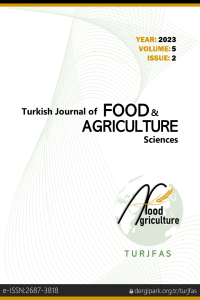Abstract
References
- Anıl, M., Durmus, Y., Tarakçı, Z. (2020). Effects of different concentrations of guar, xanthan and locust bean gums on physicochemical quality and rheological properties of corn flour tarhana. Nutrition and Food Science, 51(1), 137-150. http://dx.doi.org/10.1108/NFS-03-2020-0082
- Bilgiçli, N., Aktaş, K., Levent, H. (2014). Utilization of citrus albedo in tarhana production, Journal of Food and Nutrition Research, 53(2), 162-170.
- Çağlar, A., Erol, N., Elgün, M. S. (2012). Effect of carob flour substitution on chemical and functional properties of tarhana. Journal of Food Processing and Preservation, 37, 670-675.
- Dağlıoğlu, O. (2000). Tarhana as a traditional Turkish fermented cereal food, its recipe, production and composition. Nahrung, 44(2), 85-88.
- Erkan, H., Çelik, S., Bilgi, B., Köksel, H. (2006). A new approach for the utilization of barley in food products: barley tarhana, Food Chemistry, 97, 12–18. http://dx.doi.org/10.1016/j.foodchem.2005.03.018
- Gotcheva, V., Pandiella, S.S., Angelov, A., Roshkova, Z., Webb, C. (2001). Monitoring the fermentation of the traditional Bulgarian beverage boza. International Journal of Food Science and Technology, 36(2), 129-134. http://dx.doi.org/10.1046/j.1365-2621.2001.00429.x
- Gökmen, S. (2009), “Effect on tarhana cooked, dried and raw quince additives”, MS thesis Afyon Kocatepe University, 1-81 pages.
- Herken, E.N., Aydin, N. (2015). Use of carob flour in the production of tarhana. Polish Journal of Food and Nutrition Sciences, 65(3), 167-174. http://dx.doi.org/10.1515/pjfns-2015-0010
- Koca, A.F., Koca, I., Anıl, M., Karadeniz, B. (2006). Kızılcık tarhanasının fiziksel, kimyasal ve duyusal özellikleri. 9. Gıda Kongresi: 377-380.
- Şensoy, E., Tarakçı, Z. (2023). Effect of almond pulp addition on physical, chemical and functional properties of tarhana. Tekirdağ Ziraat Fakültesi Dergisi, 20(3), 620-630. http://dx.doi.org/10.33462/jotaf.1200426
- Tarakçı, Z., Dogan, I. S., Faik Koca, A. (2004). A traditional fermented Turkish soup, tarhana, formulated with corn flour and whey. International Journal of Food Science Technology, 39(4), 455-458. http://dx.doi.org/10.1111/j.1365-2621.2004.00803.x
- Tarakçı, Z., Anıl, M., Koca, I., İslam, A. (2013). Effects of adding cherry laurel (Laurocerasus officinalis) on some physicochemical and functional properties and sensorial quality of tarhana. Quality Assurance and Safety of Crops and Foods, 5(4), 347–355. . http://dx.doi.org/10.3920/QAS2012.0155
- Üçok, G., Cankurtaran, T., Demir, M.K. (2019). Geleneksel tarhana üretiminde kinoa ununun kullanımı. Harran Tarım ve Gıda Bilimleri Dergisi, 23(1), 22-30. http://dx.doi.org/10.29050/harranziraat.402350
Abstract
In this study, hazelnut pulp added to tarhana to increase its nutritional properties and create a new product. For this purpose, cold-pressed partially defatted hazelnut pulp obtained and added to the tarhana formulation at certain rates of 0%, 5%, 10%, 15%, 20%, 25% and 30%. Sensory tests carried out to measure the liking of tarhana with hazelnut pulp, a new product. In the sensory evaluation, all samples examined in terms of odor, color, taste-aroma, consistency, and general acceptability. Because of the sensory analysis carried out by cooking tarhana in the form of soup, it observed that there was no significant difference between the control group and the tarhana with hazelnut pulp in terms of color, smell, consistency, taste, aroma and general acceptability. However, when the sensory analysis results are examined, it is seen that tarhana with hazelnut pulp received higher scores than the control group.
Keywords
References
- Anıl, M., Durmus, Y., Tarakçı, Z. (2020). Effects of different concentrations of guar, xanthan and locust bean gums on physicochemical quality and rheological properties of corn flour tarhana. Nutrition and Food Science, 51(1), 137-150. http://dx.doi.org/10.1108/NFS-03-2020-0082
- Bilgiçli, N., Aktaş, K., Levent, H. (2014). Utilization of citrus albedo in tarhana production, Journal of Food and Nutrition Research, 53(2), 162-170.
- Çağlar, A., Erol, N., Elgün, M. S. (2012). Effect of carob flour substitution on chemical and functional properties of tarhana. Journal of Food Processing and Preservation, 37, 670-675.
- Dağlıoğlu, O. (2000). Tarhana as a traditional Turkish fermented cereal food, its recipe, production and composition. Nahrung, 44(2), 85-88.
- Erkan, H., Çelik, S., Bilgi, B., Köksel, H. (2006). A new approach for the utilization of barley in food products: barley tarhana, Food Chemistry, 97, 12–18. http://dx.doi.org/10.1016/j.foodchem.2005.03.018
- Gotcheva, V., Pandiella, S.S., Angelov, A., Roshkova, Z., Webb, C. (2001). Monitoring the fermentation of the traditional Bulgarian beverage boza. International Journal of Food Science and Technology, 36(2), 129-134. http://dx.doi.org/10.1046/j.1365-2621.2001.00429.x
- Gökmen, S. (2009), “Effect on tarhana cooked, dried and raw quince additives”, MS thesis Afyon Kocatepe University, 1-81 pages.
- Herken, E.N., Aydin, N. (2015). Use of carob flour in the production of tarhana. Polish Journal of Food and Nutrition Sciences, 65(3), 167-174. http://dx.doi.org/10.1515/pjfns-2015-0010
- Koca, A.F., Koca, I., Anıl, M., Karadeniz, B. (2006). Kızılcık tarhanasının fiziksel, kimyasal ve duyusal özellikleri. 9. Gıda Kongresi: 377-380.
- Şensoy, E., Tarakçı, Z. (2023). Effect of almond pulp addition on physical, chemical and functional properties of tarhana. Tekirdağ Ziraat Fakültesi Dergisi, 20(3), 620-630. http://dx.doi.org/10.33462/jotaf.1200426
- Tarakçı, Z., Dogan, I. S., Faik Koca, A. (2004). A traditional fermented Turkish soup, tarhana, formulated with corn flour and whey. International Journal of Food Science Technology, 39(4), 455-458. http://dx.doi.org/10.1111/j.1365-2621.2004.00803.x
- Tarakçı, Z., Anıl, M., Koca, I., İslam, A. (2013). Effects of adding cherry laurel (Laurocerasus officinalis) on some physicochemical and functional properties and sensorial quality of tarhana. Quality Assurance and Safety of Crops and Foods, 5(4), 347–355. . http://dx.doi.org/10.3920/QAS2012.0155
- Üçok, G., Cankurtaran, T., Demir, M.K. (2019). Geleneksel tarhana üretiminde kinoa ununun kullanımı. Harran Tarım ve Gıda Bilimleri Dergisi, 23(1), 22-30. http://dx.doi.org/10.29050/harranziraat.402350
Details
| Primary Language | English |
|---|---|
| Subjects | Food Chemistry and Food Sensory Science |
| Journal Section | Research Articles |
| Authors | |
| Publication Date | December 30, 2023 |
| Submission Date | October 24, 2023 |
| Acceptance Date | November 14, 2023 |
| Published in Issue | Year 2023 Volume: 5 Issue: 2 |
Cited By
Comparison of physical, chemical and sensory analyzes of tarhana containing black carrot extract and classical tarhana
Turkish Journal of Food and Agriculture Sciences
https://doi.org/10.53663/turjfas.1428794
Turkish Journal of Food and Agriculture Sciences is licensed under a Creative Commons Attribution-NonCommercial-NoDerivatives 4.0 International License.
Journal Abbreviation: Turk J Food Agric Sci

